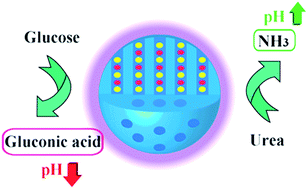A semipermeable enzymatic nanoreactor as an efficient modulator for reversible pH regulation†
Abstract
Here we propose a new concept for the fabrication of a semipermeable enzymatic nanoreactor as an efficient modulator to reversibly switch the pH of an aqueous environment. We used amino-functionalized, expanded mesoporous silica nanoparticles (EMSN) as a model nanocarrier to load enzymes. In order to protect enzymes from the interference of a complicated environment, polyelectrolyte multilayers (PEMs) were coated on the surface of the EMSN through layer by layer (LbL) assembly. These PEMs can serve as semipermeable membranes, allowing small molecules to diffuse in and out freely while trapping the enzymes in the nanoreactors. Compared with traditional electrochemical stimulation or optical control methods, our enzymatic regulation platform is easy to operate without complicated instruments. In addition, this system can cover a wide range of pH values and conveniently regulate pH values by simply controlling the concentrations of catalysts or reactants. Meanwhile, this strategy could be generalized to other enzymes or nanocarriers to achieve reversible pH regulation for different purposes. The switched pH values can be implemented for the modulation of the conformational changes of nucleic acids and activation of the charge conversion in drug delivery applications.


 Please wait while we load your content...
Please wait while we load your content...